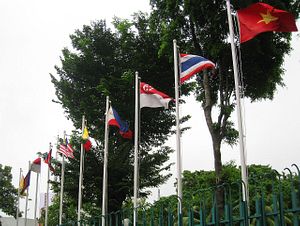The trade war between the United States and China has generated discussion in Southeast Asia about which countries will benefit from multinational companies moving production out of China, yet there has been a strange silence on the opportunities for the ASEAN Economic Community (AEC).
With a population of 662 million, a median age of 28.8 years as opposed to China’s 37, as well as member states whose growth is dependent on international trade and finance, the trade war should have been a golden opportunity for the AEC, launched in 2015, to realize its ambitions as a regional production base. The trade war also should have provided a catalyst to drive greater integration.
In the big picture, nobody wins from trade wars. However, Southeast Asia should benefit from capturing value-added production moving out of China in the interim. While ASEAN member states under the AEC would have continued to compete to attract production, the endowments of economic regionalism should have worked to make each member more attractive overall and promoted the development of regional value chains.
Yet the discussion has instead focused not on ASEAN complementation but ASEAN competition. Low-wage, high-growth Vietnam is often highlighted as the chief beneficiary of the trade war, financial hub Singapore dubbed a loser, and poorly integrated Indonesia seen as falling behind its more nimble Southeast Asian peers.
The most obvious issue is that the AEC’s implementation has been painfully slow. ASEAN has a tendency to launch grand strategies but work out the details and design the mechanisms later. The AEC Blueprint stipulates gradually implementing the AEC by 2025, yet four years after the AEC was launched fundamental issues are still under discussion.
At the 25th ASEAN Economic Ministers Retreat in Phuket in April 2019, for example, discussions continued on the ASEAN Single Window (ASW), which aims to reduce the time goods have to wait at borders from 10 to three days. Given that the AEC is supposed to promote regional value chains, the ASW should be the cornerstone of closer integration. It is thus questionable why such an important aspect of the AEC has not been agreed on.
Furthermore, the AEC Blueprint calls for the removal of nontariff barriers (NTBs), such as quotas and local content requirements. However, of the 6,000 NTBs identified in ASEAN, not a single barrier has been removed through the AEC process. Counterintuitively the number of NTBs has continued to grow.
On top of these immediate issues, the AEC suffers from structural problems that raise questions over whether regional economic integration can ever be actualized.
Fundamentally, the AEC’s institutional design is underpinned by the “ASEAN way,” which include norms such as noninterference in one another’s domestic affairs. While the “ASEAN way” was functional for facilitating peace and diplomacy in the region, which ASEAN was originally set up to promote, it is not suitable for cross-border market transactions involving private decisions and private money.
Indeed, branding the AEC an economic community or single market was misleading. A true single market generally entails positive integration, referring to formal institutions that enforce the rules of the market, and negative integration, which encompasses far reaching cross-border liberalization based on obligations of nondiscrimination and mutual market access.
The AEC’s “single market,” however, falls short of this definition. In a fully-fledged single market, market fundamentals such as competition policy are subjects of positive integration. However, the AEC stipulates for “national regulation, policy emulation and best practices.” This ambiguity means ASEAN members can forgo AEC commitments they find politically inconvenient at the domestic level.
This institutional weakness is also apparent in negative integration, namely mutual market access. For example, the movement of labor is limited to skilled labor and only provides for seven professions, while the AEC does not guarantee the right to free movement but only the facilitation of access to ASEAN labor markets.
Furthermore, dispute settlement mechanisms (DSMs) are fundamental to international institutions to address collaboration problems and enhance the credibility of commitments. To achieve this, DSMs must be independent. ASEAN’s own Enhanced Dispute Settlement Mechanism (EDSM), however, is vulnerable to politicization. The EDSM stipulates that unresolved disputes be adopted by ASEAN’s political organs such as the ASEAN Summit. Yet adjudication with political rather than independent entities means the EDSM will likely be avoided; indeed, the mechanism has never been invoked.
The AEC’s immediate implementation problems and broader structural weaknesses, as well as its misleading branding, means multinational companies and investors are unlikely to take the AEC into consideration when moving production bases abroad. The AEC has thus missed a golden opportunity in the trade war in which to accelerate its stated ambitions.
Shah Suraj Bharat is a fellow at the ASEAN Studies Center, Gadjah Mada University. Find him on Twitter @ShahSurajBharat.

































